Directing IP in DC
Directing

in

By Aisha Labi L’96
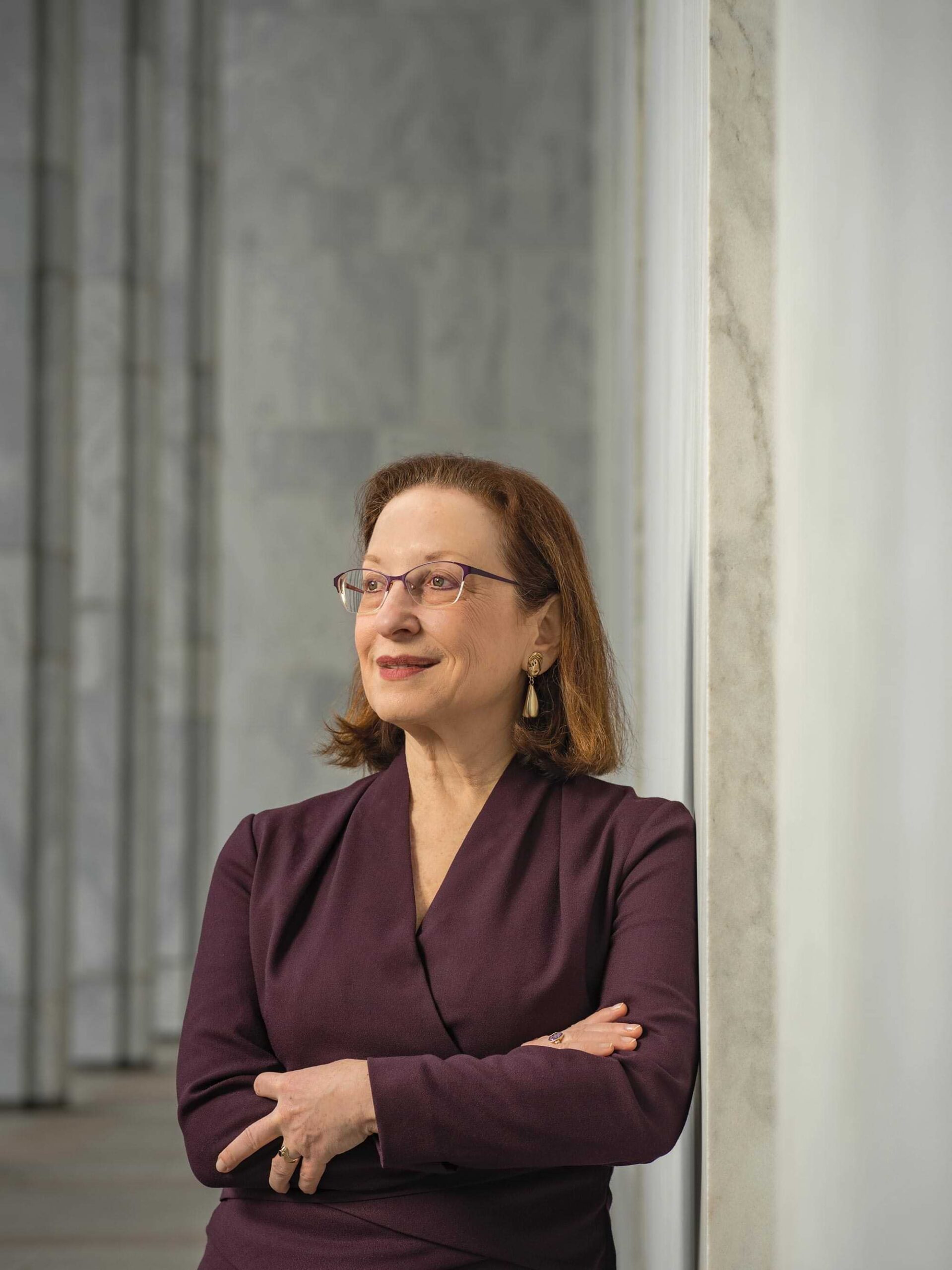
photos: stephen voss
Some say Shira Perlmutter L’83 knows more about copyright than anyone in the country.
Directing IP in DC
Directing

in

By Aisha Labi L’96
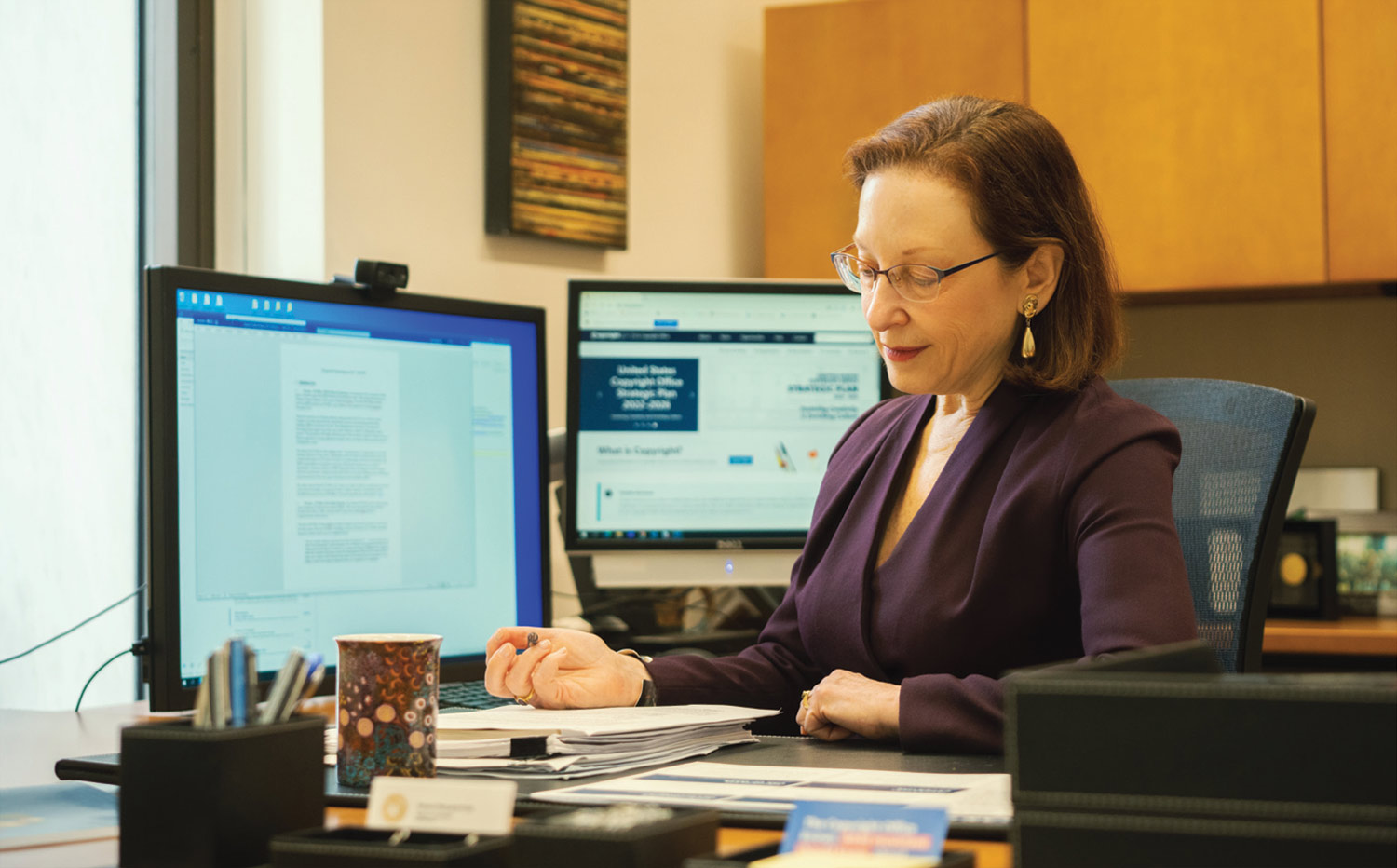

ittle in the early background of Shira Perlmutter L’83 suggested she was destined for a distinguished career in the law. Her lifelong passion is music, and she majored in linguistics as an undergraduate at Harvard, where she sang soprano in the University Choir and the Harvard-Radcliffe Collegium Musicum. It was only when she was pursuing graduate work in voice performance at Temple University, however, that her ambition to be a classical singer began to waver. Although her dedication to music remained, she cast about for an alternative career.
“I had never thought about being a lawyer,” she said. “I didn’t know any lawyers, and there were none in my family.”
Perlmutter grew up in Philadelphia, and her father Daniel, now retired, was a chemical engineering professor at Penn while her late mother, Felice, was a social work professor at Temple. It was her father who pointed her toward law; since she liked logical thinking, writing, and performing publicly, he reasoned, being a lawyer might suit her. He proved persuasive, and her path took a turn that led her to the University of Pennsylvania Carey Law School, and, eventually, to her current position as the 14th Register of Copyrights, the head of the U.S. Copyright Office.
Music remained central to Perlmutter’s life, even during law school, where she sang in the Law School Light Opera, an ensemble that performed mostly Gilbert & Sullivan. In fact, her love of music and desire to find an area of law related to music steered her to Kenneth W. Gemmill Professor, Emeritus Robert A. Gorman’s seminal copyright class. “He was an absolutely inspirational teacher and I fell in love with the field,” she said. Gorman—who sang in the Harvard Glee Club and is no musical slouch himself—remembers not only Perlmutter’s affinity for copyright law, but also her musical gifts. “She has a wonderful soprano voice and is as good as any professional I’ve ever heard outside of the concert hall,” he said of his former student.
Like Perlmutter, the government body she now heads is an idiosyncratic mix. Copyright as a form of intellectual property is rooted in the U.S. Constitution, and protecting copyrights is one of the oldest functions of the federal government. Despite its venerable history, the Copyright Office is also at the forefront of addressing some of the most cutting-edge legal issues of our time. An area of the law that derives from protecting the intellectual property expressed in printed written material now encompasses computer code, choreographed dance moves, YouTube videos, and Twitter posts, among other forms of expression. “Everyone these days is both an author and a user of copyrighted works,” said Perlmutter. “Almost every time you engage online, you are both creating something copyrighted and using something copyrighted.”
A Life in Copyright

ith such a broad scope of activity for her office, it is fitting that Perlmutter’s path since law school has been varied, spanning the private sector, academia, roles in government and at international organizations, as well as representing the interests of both copyright creators and users. “I’ve moved around quite a bit,” she said, with a common theme that each jump “was to pursue some opportunity that arose that I hadn’t been planning on but that sounded very interesting and a chance to learn something new.”
After law school, she worked in New York at Paul, Weiss, Rifkind, Wharton & Garrison, doing general commercial litigation, before moving to Cowan, Liebowitz & Latman, a boutique firm specializing in copyright and trademark law. She then joined the faculty at Columbus School of Law at The Catholic University of America, thinking that, like many in her family, she would spend the rest of her career as an academic. Her brother, Nobel Prize-winning physicist Saul, teaches at the University of California, Berkeley; her sister Tova is a nonprofit executive. However, the move to Washington, D.C., also brought with it greater exposure to the world of policy, and Perlmutter was hooked. “My training as a lawyer had been very much about interpreting and applying the law and using it to help clients. For the first time I was looking at the law as something to be shaped and molded, and I found it absolutely fascinating,” she said.
While she was at Catholic University, a position of Associate Register of Copyrights was created to head a new Office of Policy and International Affairs. She got the job, and in that capacity was deeply involved in international copyright treaty negotiations during the 1990s. After five years, she was asked to consult at the World Intellectual Property Organization on copyright and—as it was called at the time—e-commerce. This international experience brought her wide exposure and honed her diplomatic skills.
“In addition to being knowledgeable and a leading expert in the United States on these issues, she is also a very good advocate internationally and advances and defends U.S. positions extremely effectively,” said Andrei Iancu, former Under Secretary of Commerce for Intellectual Property and Director of the U.S. Patent and Trademark Office (USPTO), the other main governmental office dealing with intellectual property, which is now headed by Kathi Vidal L’96. “She has a unique set of characteristics that combine to make her very effective. She is a persistent and dogged advocate in a very friendly and professional way. Not everybody has this combination. Frankly, most lawyers and most leaders don’t.”
After this extended period of international work, Perlmutter spent several years at AOL Time Warner. The corporate sector had held little appeal for her, but AOL Time Warner’s vast reach, with businesses on all sides of the copyright issues, proved enticing. “Virtually every perspective was represented within the company, and my job was to develop a single company policy that could accommodate all of them,” she said. She followed this with a period at the International Federation of the Phonographic Industry, or IFPI, which represents the interests of record producers around the world (the international counterpart of the Recording Industry Association of America). Along the way, she has published extensively, including articles that have been cited by the U.S. Supreme Court and lower federal courts. She has also co-authored a casebook, International Intellectual Property Law and Policy.
In 2012 she returned to government service when Under Secretary of Commerce David J. Kappos hired her to head the Office of Policy and International Affairs at the USPTO. That office handles interactions with other countries, constituent groups, stakeholders, and other parts of the U.S. government, explained Kappos, who is now a partner at Cravath, Swaine & Moore. “It is a very big job in the USPTO. Shira is the consummate professional and the perfect leader for the government. She stays cool, confronts tough issues in a mature and thoughtful fashion, listens well, and is extremely clear and articulate in presenting positions.”
In 2020, she was appointed by the Librarian of Congress to head the U.S. Copyright Office, the 450-person agency responsible for administering the nation’s copyright system. The consensus among her peers is that the depth and breadth of her experience uniquely qualify her for the role of Register.
“It’s a job that she was made for,” said Jane C. Ginsburg, a copyright professor at Columbia Law and a friend of long standing. “It’s hard to think of anybody who is more authoritative, with such vast experience.”
“She is probably now THE foremost copyright expert there is,” said Kappos. “She is deeply knowledgeable and expert in the copyright field, not just on the laws and cases and how to interpret them, but also on the interests of stakeholders, from civil society to the academy to important creative enterprises to the big interest groups, like the Recording Industry Association. She also has a tremendous depth of knowledge of the international treaties in the copyright field, going way back, because she negotiated them.”
Copyright Lore

Courtesy of the U.S. Copyright Office.
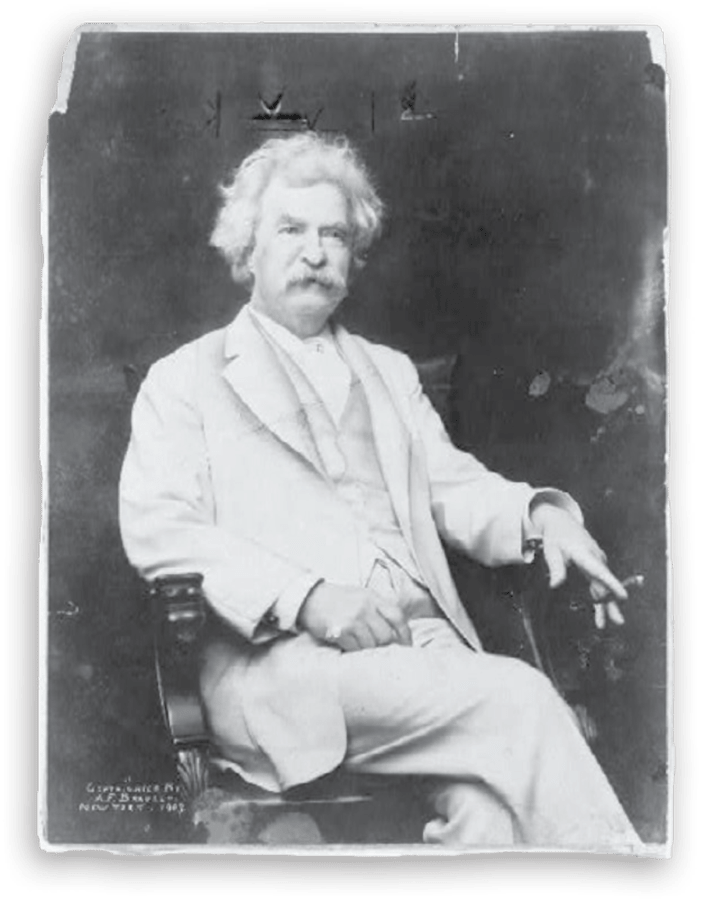
library of congress prints and photographs division
Mark Twain’s Iconic White Suit
Mark Twain wore his famous white suit for the first time when he testified about a copyright reform bill before Congress. Twain, who lost substantial income from overseas piracy of his work, was a strong proponent of copyright reform.
Statue of Liberty: Largest Copyrighted Sculpture Ever?
One of the most famous sculptural works of art ever registered, and perhaps the largest, is the Statue of Liberty. On August 31, 1876, the Copyright Office issued copyright registration number 9939-G. The “Statue of American Independence,” as the Statue of Liberty was first named. The copyright was filed in America’s Centennial year, a full ten years before the Statue was erected in New York Harbor. Originally, Lady Liberty held a broken chain and shackle in her left hand. They were later moved to her feet.
Copyright Lore

Courtesy of the U.S. Copyright Office.

library of congress prints and photographs division
Mark Twain’s Iconic White Suit
Mark Twain wore his famous white suit for the first time when he testified about a copyright reform bill before Congress. Twain, who lost substantial income from overseas piracy of his work, was a strong proponent of copyright reform.

Frédéric Auguste Bartholdi. Statue of American Independence, 1976. Prints and Photographs Division, Library of Congress
Statue of Liberty: Largest Copyrighted Sculpture Ever?
One of the most famous sculptural works of art ever registered, and perhaps the largest, is the Statue of Liberty. On August 31, 1876, the Copyright Office issued copyright registration number 9939-G. The “Statue of American Independence,” as the Statue of Liberty was first named. The copyright was filed in America’s Centennial year, a full ten years before the Statue was erected in New York Harbor. Originally, Lady Liberty held a broken chain and shackle in her left hand. They were later moved to her feet.

Star Wars: Forty Years of Copyright
More than 3,600 copyright registrations and documents have been filed for Star Wars’ works. Approximately two-thirds of the Star Wars’ registrations and documents were filed more than 20 years after the original movie was released.

Gloria Gaynor’s Hit Song “I Will Survive” Endures
Gloria Gaynor’s 1978 iconic hit “I Will Survive” is registered in the Library’s National Recording Registry. There have been many covers of the song. Owners of those sound recordings submitted copyright applications for the entire album with the song.
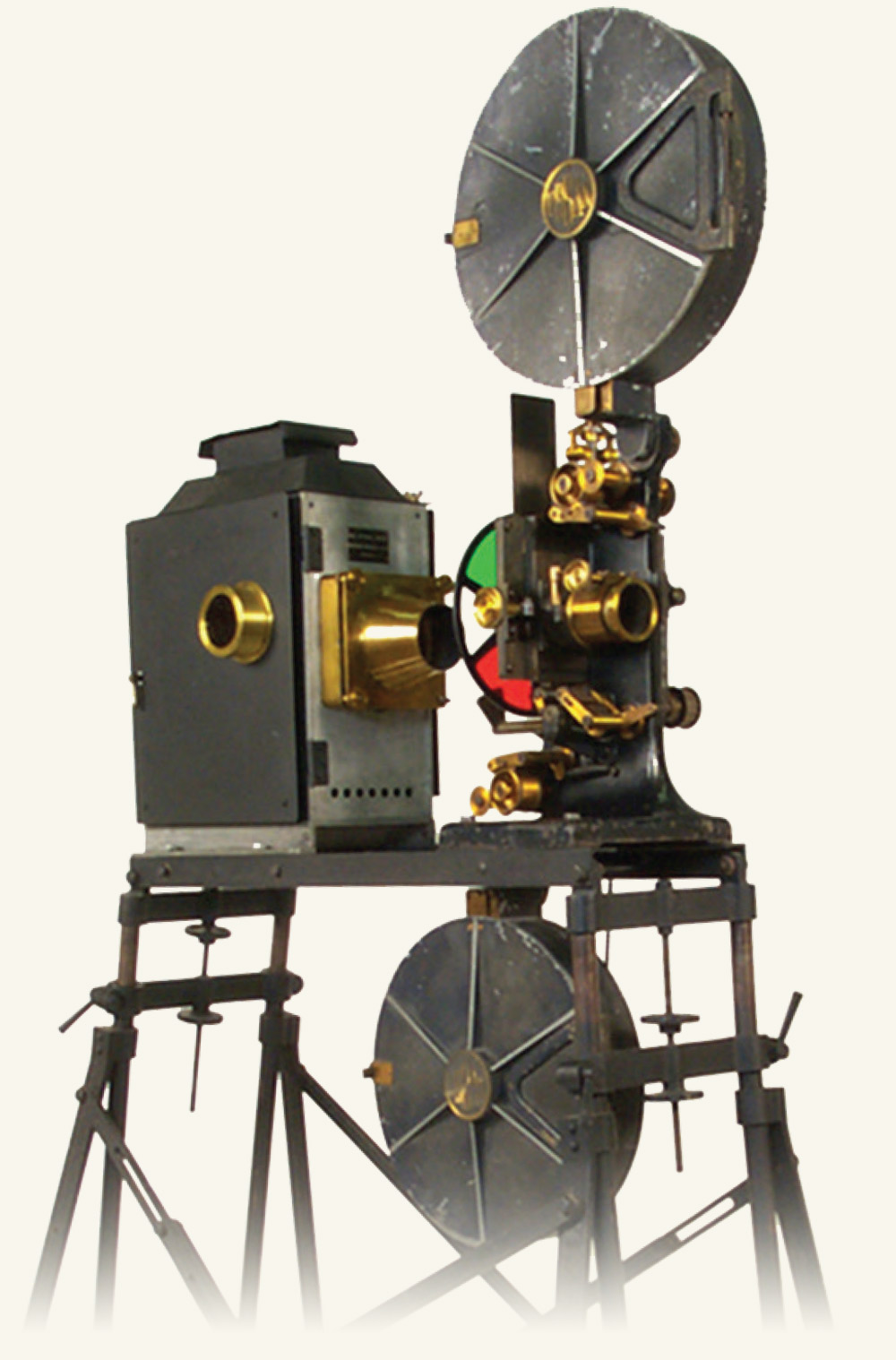
science museum group collection
Protection of First Color Cinema
On September 23, 1913, the Kinemacolor Company of America registered a film adaptation of “The Rivals,” a comedy of manners first performed in London in 1775. Kinemacolor worked by exposing black and white film through red and green filters.
Promoting Creativity

Perlmutter’s role does not encompass promulgating legislation, but her office advises Congress and is responsible for implementing many legislative changes that relate directly to copyright. The 2018 Music Modernization Act, for example, updated the music licensing system to better handle digital streaming. The Copyright Office has oversight of the new system and is reaching out to musicians and songwriters to inform them how to use it to collect royalties. In 2022, some $700 million in royalties was distributed through this new Mechanical Licensing Collective.
Another legislative landmark, the Copyright Alternative in Small-Claims Enforcement (CASE) Act of 2020, tasked the Copyright Office with establishing the Copyright Claims Board (CCB), a small-claims tribunal for the adjudication of copyright claims of up to $30,000. The CCB is intended to provide access to justice for those without the resources to litigate in federal court. It opened its virtual doors last June and has received nearly 400 claims as of early March, about half of which relate to works of visual art; more than half were filed by pro se claimants.
Outreach and communication are central to the function of the Copyright Office and Perlmutter identifies what she calls “Copyright For All” as her overarching priority. “We want to make the copyright system as accessible and understandable as possible to as many members of the public as possible, because everyone is touched by and affected by copyright these days,” she explained.
One of the Office’s four associate register positions is dedicated to public information and education, and Perlmutter herself takes every opportunity to spread her message. “She’s an extraordinary public speaker,” said Ginsburg. “There’s nobody I can think of who takes pretty complicated topics and presents them with such astounding clarity.”
Perlmutter is especially focused on outreach to groups that have historically been underrepresented in the copyright system, such as women and other underserved communities. A report the Office recently published examined more than 40 years of registration records and found that women authors were far less likely to register their work than male authors. That gender gap is shrinking, and women now comprise about half of the registrants for nonfiction literary works, but they are still underrepresented in other types of works, such as those relating to STEM subjects.
The government’s other, much larger, intellectual property agency, the 13,000-strong USPTO, headed by Vidal, has also prioritized expanding participation and has created a Council for Inclusive Innovation, on which Perlmutter serves as a Co-Vice Chair. Although the offices’ functions and responsibilities differ, they are complementary and are working more closely than ever, said Perlmutter. “We’re both of the mindset that the more collaboration the better.”
Vidal underscores the importance of their joint emphasis on outreach. “Register Perlmutter and I work together closely to ensure that all Americans have access to innovation, entrepreneurship, and creativity ecosystem and have the tools and support necessary to bring their ideas and creations to impact,” she said. “She is a smart, thorough, and dedicated steward of our nation’s vibrant copyright system, and I am proud to work with her in service of our nation’s dynamic creators to help promote intellectual property and the importance of protecting and respecting it.”
Both agencies are also grappling with how to evaluate some of the newest forms of creative output. Congress has asked for an assessment of the intellectual property implications of Non-Fungible Tokens (NFTs), and each office produced daylong programs on the issues. A related subject is the fast-growing amount of content generated using artificial intelligence (AI). Last year the Copyright Office rejected an attempt to register a work claimed to be created entirely by artificial intelligence, on the basis that human authorship is a prerequisite for copyright protection. The resulting case, Thaler v. Perlmutter, has been appealed and will become an important test of how AI-generated works are handled. “One of the pleasures of the job I’m in is that for the first time in my life I’m a named party in litigations,” Perlmutter joked.
If Thaler is upheld, it will in turn raise other policy questions, such as whether the law should be changed to provide copyright or other forms of intellectual property protection for works created by a computer. Meanwhile, the Copyright Office will need to assess the copyrightability of works created using AI in conjunction with human authorship. Another hot issue, said Perlmutter, is how to deal with works that are produced by machine learning through the ingestion of vast quantities of copyrighted material, such as works of art or music.
“A lot of creators are getting quite concerned about their work being used to generate material that may be commercially valuable without their permission and without any compensation,” she said. The fair use doctrine, a central tenet of American copyright law, has long allowed unauthorized use of copyrighted material in appropriate circumstances in order to foster creativity. However, as more content is generated through the ingestion of copyrighted material, there are questions about how the law should deal with different uses of that newly generated content, said Perlmutter.
Issues that seemed theoretical just a few years ago are now very real and pressing, observed Perlmutter. As the prowess of programs like DALL-E and Chat GPT dominates headlines—generating wonder and alarm in equal measure—the Copyright Office will be at the forefront of examining how the legal issues raised by these technological advances should be addressed.
“We always are keeping up with what is happening and the copyright implications, first of all for our registration system and other services, but also because Congress and other agencies come to us for advice,” she said. Public consultation will be a key part of the process as the Copyright Office looks at these issues in the coming year and considers possible recommendations.
For Perlmutter, no matter how esoteric and complex the technology in question, the issues facing her office boil down to human creativity. “I believe strongly in what copyright is all about and the mission of the Copyright Office, which is promoting creativity and enriching our cultural heritage and knowledge base,” she said.
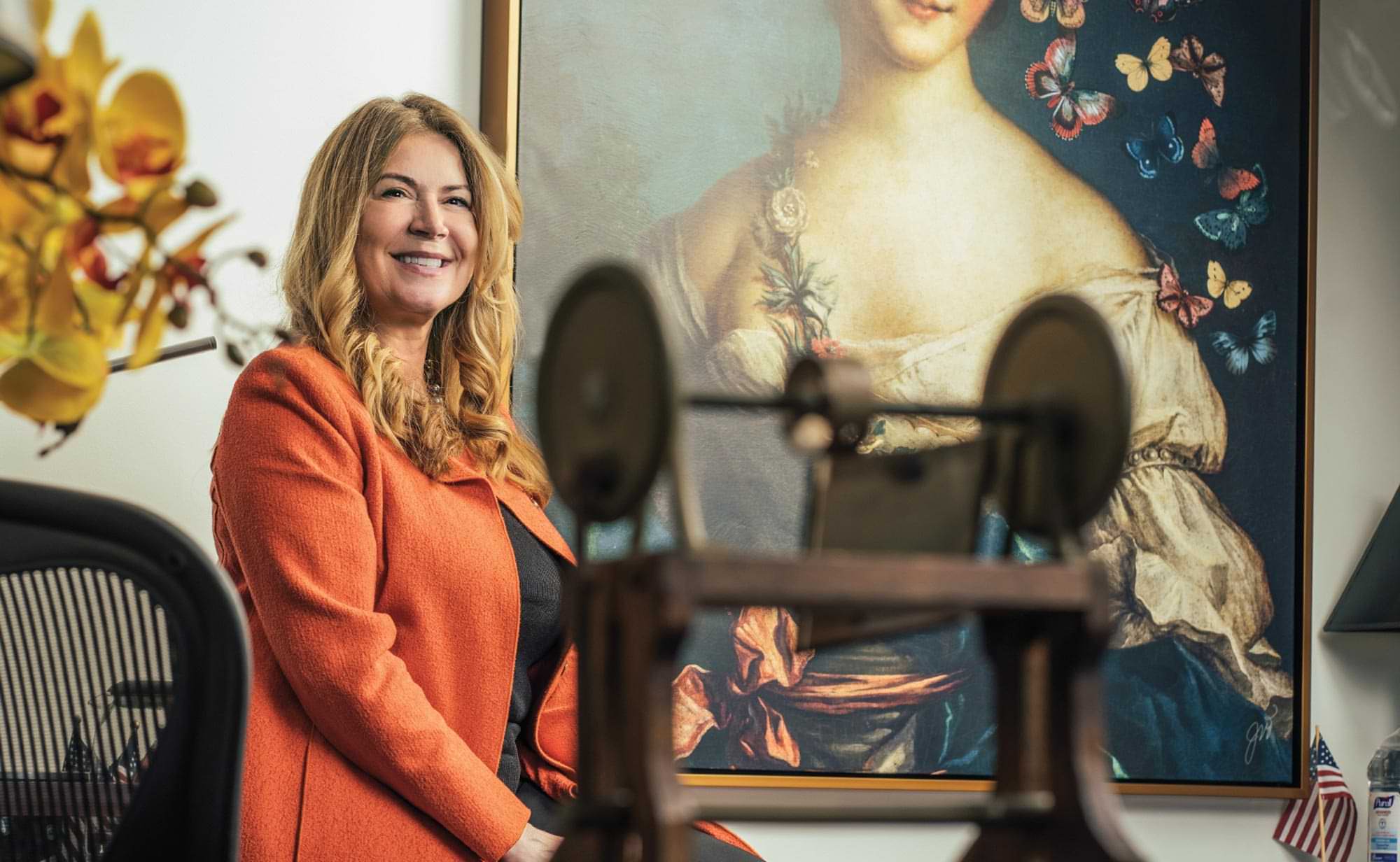
 An experienced Silicon Valley hand, Kathi Vidal L’96 is now overseeing patents and trademarks as head of that office in Washington, D.C.
An experienced Silicon Valley hand, Kathi Vidal L’96 is now overseeing patents and trademarks as head of that office in Washington, D.C.Kathi Vidal L’96 Out to Expand Innovation as Head of Patent and Trademark Agency
By Lindsay Podraza

athi Vidal L’96 remembers perusing a garage sale in high school and spotting a treasure: a fully functional oscilloscope. “I loved looking at the waveforms just for fun,” she said.
A few years later, as an undergraduate mathematical physics major, she took a summer course in organic chemistry. “I didn’t get credit for it, but I was extremely interested in that area of science,” Vidal said. Later, as an electrical engineer at General Electric, she masterminded the joystick still used in C17 aircraft today.
Her enthusiasm for science, innovation, and a continual quest to improve the world eventually led to her current posts as Director of the United States Patent and Trademark Office (USPTO) and Under Secretary of Commerce for Intellectual Property. Vidal, who took the helm in April 2022, leads more than 13,000 employees with an annual budget of more than $4 billion. She also serves as the Principal Intellectual Property (IP) Advisor to President Biden and his administration.
The USPTO, which is an independent agency within the Department of Commerce, protects ideas, brands, and companies. The country’s IP office is robust, Vidal said: “Overall, the United States has a very strong and efficient IP system that really incentivizes innovation, brands moving forward, creating jobs, and encouraging prosperity.”
‘Reaching Everyone’

om Melsheimer, who is the Managing Partner of Winston & Strawn’s Dallas office, has known Vidal for over 20 years. “There’s a ‘Where’s Waldo’ aspect to her—she’s everywhere doing everything, it seems, whether it’s legal work or mentoring work or rowing or running a marathon,” Melsheimer said. He worked with her at Fish & Richardson and later recruited her to join him at Winston & Strawn in 2017. “She has a lot of irons in the fire, but she has a level of excellence in everything she does.”
One of Vidal’s overarching goals for the USPTO is to expand innovation nationally and educate citizens about the IP system and applying for protection. “It’s all about scale, about reaching everyone,” Vidal said, adding that bringing together government agencies—like the Department of Commerce, the Minority Business Development Agency, the International Trade Administration, and the Small Business Administration—will help everyday Americans bring more inventions and technology to market.
Several initiatives are underway to achieve expansion. Camp Invention, which the Office founded in 1990 in partnership with the National Inventors Hall of Fame, annually reaches more than 280,000 children in 2,500 schools nationwide. Its programming, taught by specially trained teachers, includes hands-on STEM activities and educates children about how the USPTO works and the importance of patents, trademarks, and copyrights. Last year, two-thirds of participating students came from underserved communities.
“We are constantly doing work with schools and teachers directly to make sure we’re incentivizing innovation,” Vidal said, adding that drafting competitions have also helped foment youths’ inventions. “After a week (at Camp Invention), kids were asking, ‘How can I protect my merch on the internet?’ It’s fantastic.”

Overall, the United States has a very strong and efficient IP system that really incentivizes innovation, brands moving forward, creating jobs, and encouraging prosperity.”
kathi vidal L’96
Director, United States Patent and Trademark Office
Championing women and diversity in the innovation field have been hallmarks of Vidal’s career, particularly through mentorship.
After hearing a presentation on mentoring at her first Fortune’s Most Powerful Women dinner, Vidal was inspired to take part. She ended up connecting with Susan Wojcicki, the former CEO of YouTube, and Megan Smith, the former Chief Technology Officer of the United States, and took on a mentee in South Africa. The woman ran an orphanage with 200 children but didn’t know how to stay financially afloat. “Instead of using funds that came to the orphanage to help pay for food and workers, we encouraged her to buy sewing machines, and she used them to make products to sell and to become sustainable,” Vidal said.
Since that experience, Vidal has continued to mentor and empower women around the world. “The experience is phenomenal, and it’s mutual learning,” she said, noting that such mentorships can also have a ripple effect. “It can lift those women, and it really makes a difference in those countries.”
Domestically, Vidal serves as Vice Chair of the Council for Inclusive Innovation (CI2) alongside Secretary of Commerce Gina Raimondo, who chairs CI2. The Council was formed following a 2019 study by the USPTO that found women and minorities are underrepresented as U.S. patent-certified inventors. The Council’s mission is to develop a national strategy for those groups to participate more in the USPTO system. One solution is this year’s launch of an innovation internship program; another is a first-time filer system that helps first-time filers who are under-resourced obtain feedback on their applications more quickly. “We have a lot of ideas moving forward on how to connect with people and how to get funding,” Vidal said. “We’re figuring out how to meet them early to protect their intellectual property before it’s too late and then use that funding to bring products to market.”
Protection and Prosperity

U.S. Register of Copyrights
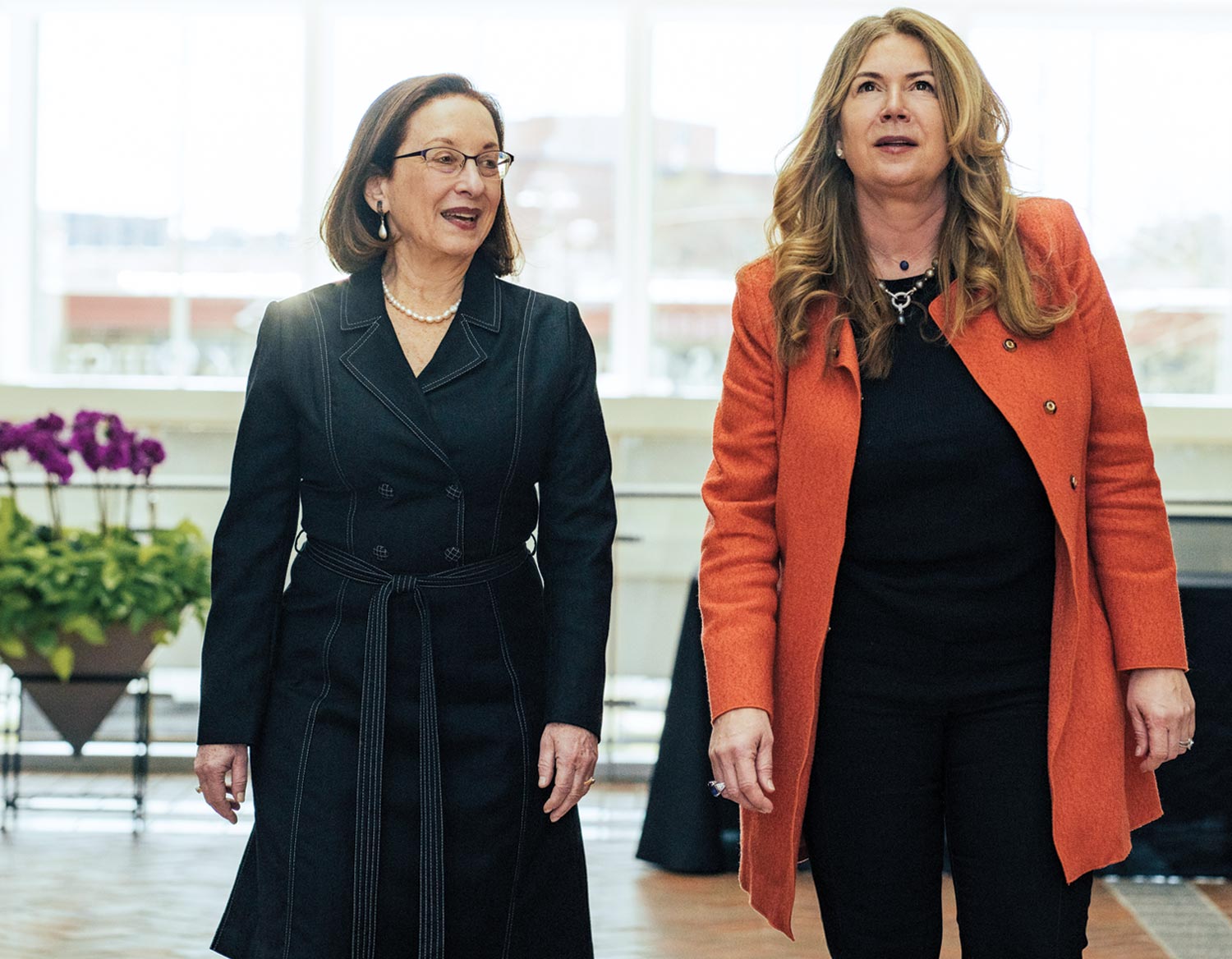
 Shira Perlmutter L’83, Register of Copyrights, and Kathi Vidal L’96, Director of the United States Patent and Trademark Office, have teamed up to untangle complex issues involving intellectual property in the technology age.
Shira Perlmutter L’83, Register of Copyrights, and Kathi Vidal L’96, Director of the United States Patent and Trademark Office, have teamed up to untangle complex issues involving intellectual property in the technology age.
The two women have wasted no time joining forces, as several initiatives are underway between their two offices. “It’s perhaps the most collaborative relationship the two agencies have ever had, because the two of us take it very seriously,” Perlmutter said. Projects include a joint study on the IP implication of non-fungible tokens (NFTs) per the request of Congress and a coordination of responses to IP-related issues arising from artificial intelligence (AI). Controversial topics surrounding AI and copyright, Perlmutter said, include potential protection of works created by AI, the combination of human and AI authorship, and how to approach the combination of human authorship and AI. “It’s a big can of worms, and we’re going to try to unpack those worms over the next year,” Perlmutter said.
The USPTO is an extraordinary hub of activity. In fiscal year 2022, the office issued 361,435 patents and registered 453,588 trademarks, part of the total 12.6 million patents to date.
With such volume, the office has its share of challenges. Loophole-seekers attempt to cash in on statutes or behaviors that haven’t yet been addressed. Vidal said others have abused the system in trying to challenge patents after they have been issued for private gain, and that foreign companies will file fraudulent trademarks to the registry in an attempt to clog the system. “We work to keep the system clean,” Vidal said.
Intellectual property protection plays a vital role in national security and commerce. The shield of protection, Vidal said, gives patent-holders the power to decide where manufacturing takes place, and effectively, where jobs are created.
The USPTO regularly meets with their counterparts in Europe, Japan, Korea, and China, the other largest IP offices in the world. “We’re raising it up a level,” she said. “We need to make sure we have a level playing field so American brands can launch worldwide.”
Vidal said ensuring anti-piracy and anti-counterfeiting measures is a paramount focus of her office. “The National Crime Prevention Council is collaborating with stakeholders on the role the U.S. government should play in having those discussions not just in the United States but with all allies and helping them crack down on counterfeiting and piracy,” she said.
Patent protection also has far-reaching effects on the American public. For example, the pre-existing patent on mRNA technology allowed for the COVID-19 vaccines to be rapidly developed, Vidal said. “We never would have seen companies collaborating (as they did) if they didn’t patent and instead relied on keeping ideas as trade secrets,” she said.
Following Her Joy

During her time at Penn Carey Law, she served as Editor-in-Chief of the University of Pennsylvania Law Review. A fellow engineering undergraduate, Sidney Rosenzweig L’96, who is now an Attorney Advisor and Acting Assistant General Counsel for the U.S. International Trade Commission, worked on the Law Review at the same time. He said her leadership at the Law School translated well to her current role. “She was a consensus builder who got things done effectively and without any drama or hurt feelings along the way,” Rosenzweig said. “More broadly, coming from an engineering perspective, she has a problem-solving mentality well-suited to addressing the tasks on her plate, whether that’s at school, on the Law Review, or now, at the PTO.”
After graduating from the Law School, Vidal clerked for Judge Alvin Schall on the U.S. Court of Appeals for the Federal Circuit before joining Fish & Richardson P.C.
“It was a firm of opportunity that really helped me develop the mindset of how I looked at things and speaking up when there was a way to do things better,” she said. In her second year there, Vidal asked to be involved in hiring at the office. She instituted the first recruitment dinner with Federal Circuit clerks, a tradition that spread to other firms and continues today.
Vidal was a junior partner when Fish & Richardson executives tapped her to lead a litigation group of 270 attorneys in 11 global offices—basically 60 percent of the firm. “At that time, I didn’t ask for that position, I had said, ‘Here’s my thinking on what we could do more with this group,’” said Vidal, who also served on the Management Committee. “If I thought things could be better, I shared the idea and then I ended up being chosen for these positions.” She became a recognized IP law expert at Fish & Richardson.
In 2017, Melsheimer persuaded Vidal to join Winston & Strawn LLP, where she served on its Executive Committee and as Managing Partner of the firm’s Silicon Valley office.
“She is high energy, charismatic, and very relationship-focused,” Melsheimer said. “I was profoundly disappointed that she left (the firm) . . . but I was extremely happy for her in her new role.”
Success at work is dependent on personal well-being, said Vidal, who is an avid athlete. She currently plays golf but has also competed in polo, rowing, and running marathons. “A strong body creates a strong mind,” she said. Vidal also enjoys photography, particularly of nature and children, and said it has always been important to take care of her family in tandem with her career.
Professionally, the biggest key to success, Vidal said, has been to consistently educate herself on pertinent subject matter and then provide solutions to problems. With that method, doors have continued to open. “I ask, ‘How can I contribute to our country and to the world?’” she said. “It gives me joy.”